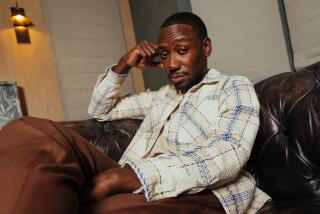Cinematographer found that retro vibe in light and color for ‘Fargo’
- Share via
Canada’s scene-stealing snowscape essentially costarred in “Fargo’s” visually stunning first season, which yielded 18 Emmy nominations and three wins for the FX limited series last year. By contrast, “Fargo” Season 2, set in 1979, owes much of its cinematic splendor to ‘70s-era image-making in general and to Memphis-born street photographer William Eggleston in particular.
“He’s the godfather of color photography,” said “Fargo’s” Emmy-nominated director of photography, Dana Gonzales. “When Eggleston came along in the early ‘70s, he shot everything on Kodachrome, which has a very vibrant look in the way it renders oranges, yellows and primary colors. When you look at his work from the ‘70s, you’re seeing the era, you’re seeing wardrobe and car colors and textures. I felt that should be the blueprint for Season 2.”
To further sell the retro vibe while filming in Calgary, Canada, Gonzales relied on old-fashioned technology when it came to practical lighting. “I decided to only use the types of lights that would have been used during this era,” he said. “Back then, the mercury and sodium vapor lighting you see everywhere now was not widespread.”
I went to great lengths creating a mood with this kind of lighting because it pulls the audience into the world when the story takes place.
— Dana Gonzales

Kirsten Dunst chats with Los Angeles Times entertainment writer Glenn Whipp about her show “Fargo.”
In search of period-perfect nighttime ambience, Gonzales and his team replaced every sodium-lamp streetlight in the Canadian town standing in for Luverne, Minn., where hapless butcher Ed and his beautician wife, Peggy, have their shops. “We changed the bulbs of that whole street back to warm tungsten lights,” Gonzales recalled. “I went to great lengths creating a mood with this kind of lighting because it pulls the audience into the world when the story takes place. People come up to me all the time and say, ‘Fargo reminds me of this street I used to live on in the ‘70s’ without knowing why. Well, a lot of that feeling has to do with the color of the light.”
Gonzales, who broke into show business as a 20-year-old truck driver on summer break from Pierce College in Woodland Hills, shot most of the show on a single ARRI Alexa digital camera outfitted with half-century-old Cooke lenses.
“‘Fargo’ being a period piece, I felt I should shoot on period lenses because vintage lenses have different coatings, different glass,” Gonzales said. “If you go back to a movie like ‘The French Connection,’ it looks a certain way partly because of the film stock and also because of the glass in the lenses. That was the next level for me: to shoot ‘Fargo’ with the same kind of lenses used for films of the ‘60s and ‘70s.”
Unlike the relatively spare storyline presented in “Fargo’s” first season, the 2015 “Sioux Falls Massacre” saga encompassed a sprawling cast of characters including Kansas City hitmen (Brad Garrett and Bokeem Woodbine), the Gerhardt crime family (led by Jean Smart and Jeffrey Donovan), folksy cops Lou Solverson and Hank Larsson (Patrick Wilson and Ted Danson) and a hapless small-town couple (Kirsten Dunst and Jesse Plemons). To streamline the narrative, series creator Noah Hawley deployed the old-school split-screen format for key transitions after studying Tony Curtis’ 1969 thriller “The Boston Stranger” on Gonzales’ recommendation. “That movie did an incredible job of telling simultaneous stories with split screen,” Gonzales said. “We felt that split-screen would be an incredible way to track all these characters and locations within the episode: Where’s the Gerhardt family? Where are the guys from Kansas City? Where’s Peggy? Where’s Ed?”
By design, TV’s “Fargo” pays homage to the Coen brothers’ precision-tooled cinematic universe beginning with their original 1996 “Fargo” film. Season 2 also drew inspiration from a chilling sequence in the filmmakers’ 1999 gangster movie “Miller’s Crossing.” “When I think about ‘Millers Crossing,’ I think about the trees when John Turturro’s screaming and they take him out to the forest and whack him,” Gonzales said. “The first year of the show, it was more about this barren frozen tundra, whereas for me, it was wooded areas became the signature landscape that made Season 2 special and different.”
Gonzales said he remembers using his digital/vintage hybrid camera rig to micro-manage a sun-dappled country-road confrontation. “I needed the location to have a particular look so that when Ted Danson walked away, the sunlight gets broken up by the trees,” he said. “In ‘Fargo,’ there’s no improv, no ‘What do you feel should happen here?’ In ‘Fargo,’ every shot means something.”
MORE:
Kirsten Dunst sees an ‘Orange Is the New Black’ future for her ‘Fargo’ character
Kirsten Dunst is happy people are seeing her work in ‘Fargo,’ but wishes grandma could have too
calendar@latimes.com
More to Read
From the Oscars to the Emmys.
Get the Envelope newsletter for exclusive awards season coverage, behind-the-scenes stories from the Envelope podcast and columnist Glenn Whipp’s must-read analysis.
You may occasionally receive promotional content from the Los Angeles Times.










